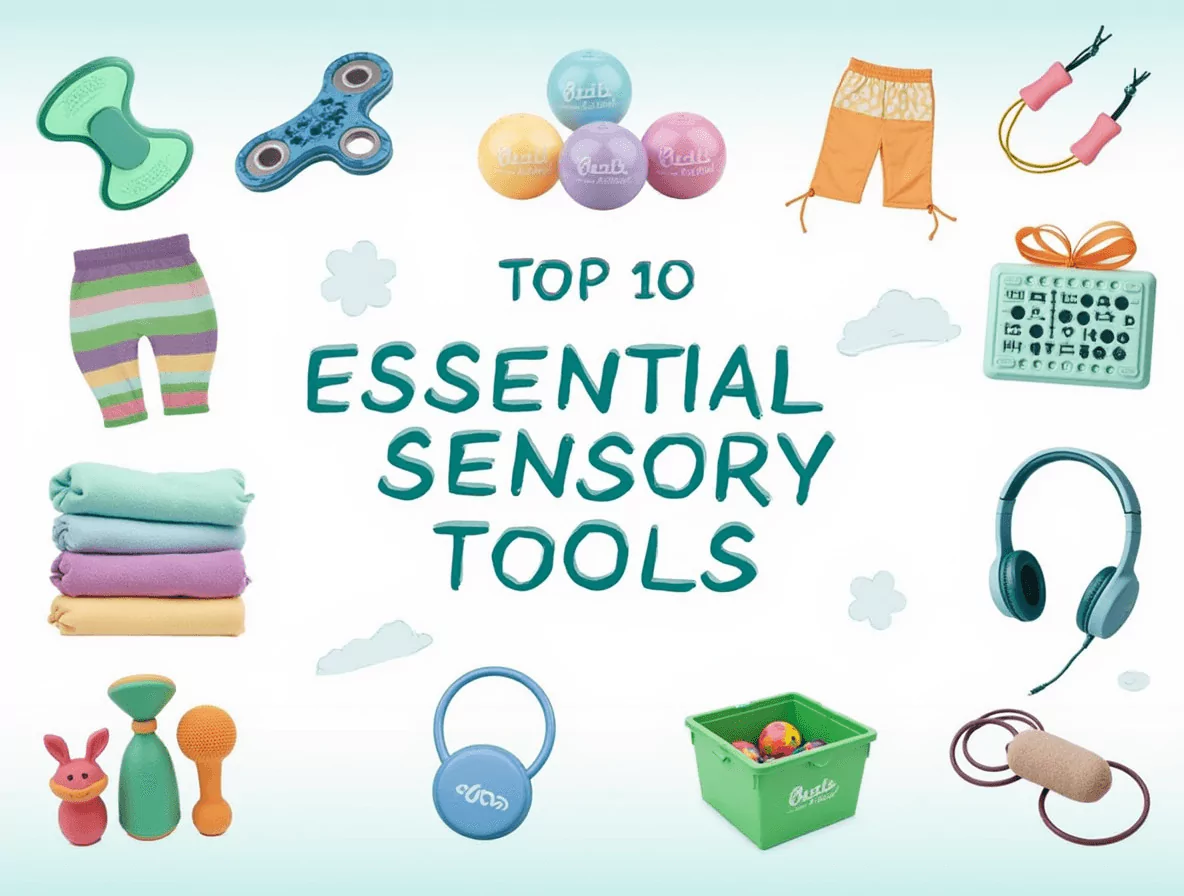With 9 years of experience in the kitchen, I’m passionate about crafting delicious recipes and sharing them with food lovers worldwide. 🍽️✨ Whether it’s a comforting homemade dish or a creative cocktail, my goal is to make cooking fun, easy, and enjoyable for everyone. Join me on this flavorful journey! 🍹🥗

Autism Products: 10 Must-Have Sensory Tools [2025 Guide]
Autism Products: 10 Must-Have Sensory Tools [2025 Guide]
Why Sensory Tools Matter in 2025
In 2024, the focus on inclusivity and understanding neurodiversity is stronger than ever. Sensory tools play a crucial role in bridging the gap between the environment and the individual’s needs. They are not simply toys or gadgets; they are tools designed to support sensory regulation, improve communication, enhance learning, and promote overall well-being. By providing tailored solutions, these products empower individuals with autism to navigate daily life with greater confidence and independence. You can learn more about neurodiversity at Wikipedia.
Understanding Sensory Processing and Autism
Sensory processing refers to how the nervous system receives and interprets information from the environment through the senses: sight, sound, touch, taste, and smell, as well as proprioception (body awareness) and vestibular sense (balance and spatial orientation). Many individuals with autism experience sensory processing differences, meaning they may be over- or under-sensitive to certain stimuli. This can manifest in various ways, such as discomfort with bright lights, sensitivity to loud noises, aversion to certain textures, or a constant need for movement. Understanding these sensory sensitivities is crucial for selecting the most appropriate tools to provide support and promote sensory regulation.
10 Must-Have Sensory Tools for Support & Development
Here’s a curated list of ten essential items that can significantly improve the quality of life for individuals with autism in 2024:
1. Weighted Blankets: Comfort and Calming
Weighted blankets are designed to provide deep pressure stimulation, which can have a calming effect on the nervous system. The gentle pressure mimics the feeling of being hugged or swaddled, reducing anxiety and promoting relaxation. These tools are particularly helpful for individuals who experience sensory overload or have difficulty falling asleep. Choose a weight that is approximately 10% of the individual’s body weight, plus one or two pounds. Weighted blankets can be especially useful during transitions or stressful situations.
2. Sensory Toys: Engaging and Therapeutic Play
Sensory toys come in a wide variety of textures, shapes, and colors, offering a rich source of sensory input. These items can include squishy balls, textured blocks, light-up toys, and musical instruments. Sensory toys encourage exploration, promote fine motor skills, and provide a healthy outlet for sensory seeking behaviors. They can also be used as calming tools during moments of anxiety or frustration. Ensure that sensory toys are age-appropriate and made from non-toxic materials.
3. Noise-Cancelling Headphones: Creating a Calm Environment
Many individuals with autism are highly sensitive to loud or unexpected noises. Noise-cancelling headphones can effectively block out distracting sounds, creating a calm and focused environment. These tools are particularly useful in crowded or noisy settings, such as schools, shopping malls, or public transportation. Choose headphones that are comfortable to wear for extended periods and provide a high level of noise reduction. They are valuable for promoting concentration and reducing sensory overload.
4. Fidget Toys: Reducing Anxiety and Improving Focus
Fidget toys are small, handheld objects that can be manipulated to provide a tactile outlet for excess energy or anxiety. Common examples include stress balls, fidget spinners, and textured cubes. These tools can help individuals with autism to regulate their emotions, improve focus, and reduce restless movements. Fidget toys are discreet and portable, making them ideal for use in classrooms, workplaces, or during social events. Ensure that fidget toys are safe and do not pose a choking hazard.
5. Visual Timers: Managing Time and Expectations
Visual timers provide a clear and concrete representation of time, helping individuals with autism to understand and manage expectations. Unlike traditional clocks, visual timers show the passage of time in a visual format, such as a disappearing color or a countdown bar. These tools are particularly helpful for managing transitions, completing tasks, and reducing anxiety about deadlines. Visual timers can be used at home, in the classroom, or in therapy sessions.
6. Adaptive Clothing: Promoting Comfort and Independence
Adaptive clothing is designed to address the sensory sensitivities and functional needs of individuals with autism. These items may feature soft, seamless fabrics, tagless designs, and adjustable closures. Adaptive clothing can eliminate irritating seams, reduce skin irritation, and promote independence in dressing. Common examples include weighted vests, compression garments, and sensory-friendly socks. Choosing comfortable and functional clothing can significantly improve the daily comfort and well-being of individuals with autism. Consider visiting our about page for more information.
7. Communication Tools: Facilitating Expression
Communication is fundamental to social interaction and personal expression. For individuals with autism who have difficulty with verbal communication, various communication tools can facilitate expression and understanding. These tools include picture exchange systems (PECS), communication boards, and speech-generating devices (SGDs). These tools allow individuals to express their needs, wants, and ideas in a clear and effective manner. Early intervention and consistent use of communication tools can significantly improve social skills and overall quality of life. Speech-generating devices can be especially helpful and you can learn more about those through research or by contacting our services.
8. Social Stories: Understanding Social Situations
Social stories are short, personalized stories that describe social situations in a clear and concise manner. These tools help individuals with autism to understand social cues, expectations, and appropriate behaviors. Social stories can be used to prepare for new experiences, address challenging behaviors, or teach specific social skills. They are typically written from the individual’s perspective and use simple language and visuals. Social stories are valuable tools for promoting social understanding and reducing anxiety in social situations. You can find various examples of social stories online or consult with a therapist or educator to create personalized stories.
9. Chewable Jewelry: A Safe Sensory Outlet
Many individuals with autism have a need to chew on objects as a way to regulate their emotions or sensory input. Chewable jewelry provides a safe and hygienic alternative to chewing on clothing, pencils, or other potentially harmful items. These tools are made from non-toxic, durable materials and come in a variety of shapes, sizes, and textures. Chewable jewelry can help to reduce anxiety, improve focus, and prevent damage to personal belongings. Choose chewable jewelry that is appropriate for the individual’s age and chewing strength. Please check out our contact page for ways to get in touch for more information.
10. Sensory Swings: Providing Vestibular Input
Sensory swings provide vestibular input, which is essential for balance, coordination, and spatial orientation. Swinging can have a calming effect on the nervous system, reducing anxiety and promoting relaxation. These tools are particularly helpful for individuals who seek sensory input through movement. Sensory swings come in a variety of styles, including hammock swings, platform swings, and pod swings. Ensure that the swing is installed safely and that the individual is supervised during use.
Choosing the Right Sensory Tools: A Personalized Approach
Selecting the most appropriate tools requires a personalized approach based on the individual’s specific sensory sensitivities, developmental level, and personal preferences. It is essential to consult with therapists, educators, and family members to identify the most pressing needs and challenges. Consider the individual’s sensory profile, communication skills, and learning style when making product selections. Trial and error may be necessary to find the tools that are most effective. Remember that what works well for one individual may not work for another. Flexibility and adaptability are key to finding the right solutions.
Safety Considerations When Selecting Sensory Tools
Safety should always be a top priority when selecting sensory tools. Ensure that all products are made from non-toxic materials and are free from harmful chemicals. Check for small parts that could pose a choking hazard, especially for young children. Consider the individual’s physical abilities and limitations when choosing products that require movement or physical manipulation. Always supervise children during the use of sensory products and provide clear instructions on how to use them safely. Regularly inspect products for wear and tear and replace them as needed. By prioritizing safety, you can ensure that sensory tools provide a positive and beneficial experience.
Where to Buy Sensory Tools
Sensory tools are available from a variety of sources, including online retailers, specialty stores, and therapy centers. Many online retailers offer a wide selection of sensory toys, adaptive clothing, and communication tools. Specialty stores often carry a curated collection of items that have been specifically designed to meet the needs of individuals with autism. Therapy centers may also offer recommendations and resources for purchasing sensory tools. Before making a purchase, read reviews, compare prices, and check the return policy. Consider purchasing from reputable vendors who specialize in sensory tools and have a proven track record of quality and customer satisfaction.
Integrating Sensory Tools into Therapy and Daily Life
Sensory tools can be effectively integrated into therapy sessions, educational settings, and daily routines. Therapists can use sensory toys to promote sensory regulation, communication tools to facilitate expression, and social stories to teach social skills. Educators can incorporate sensory tools into the classroom to create a more inclusive and supportive learning environment. Parents and caregivers can use sensory tools at home to promote comfort, reduce anxiety, and enhance overall well-being. Consistency and collaboration are key to successful integration. By working together, therapists, educators, and families can create a comprehensive support system that utilizes sensory tools to their full potential.
Future Trends in Sensory Tools and Technology
The field of sensory tools and technology is constantly evolving, with new innovations emerging regularly. Future trends include the development of more sophisticated sensory technologies, personalized learning platforms, and assistive devices. Virtual reality (VR) and augmented reality (AR) are being explored as tools for social skills training and exposure therapy. Artificial intelligence (AI) is being used to create personalized learning programs and communication aids. As technology continues to advance, sensory tools will become even more effective, accessible, and tailored to individual needs. Staying informed about the latest trends and advancements can help individuals with autism and their families to benefit from the most cutting-edge solutions.
Additional Resources and Support
Navigating the world of autism can be challenging, but there are many resources and support systems available to help. Organizations such as the Autism Society of America and the National Autistic Society offer information, resources, and support groups for individuals with autism and their families. Therapists, educators, and medical professionals can provide personalized guidance and support. Online forums and social media groups can connect individuals with autism and their families, providing a sense of community and shared experience. Remember that you are not alone, and there is a wealth of support available to help you navigate the journey.




